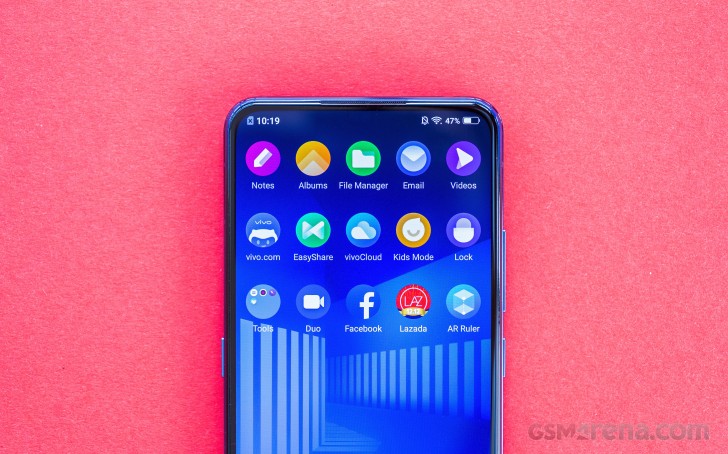Vivo NEX Dual Display 5
Performance
The performance section of this review is actually going to be a pretty short one. It's not that we didn't want to test the familiar Snapdragon 845 and its 4x2.7 GHz Kryo 385 Gold & 4x1.7 GHz Kryo 385 Silver working alongside the exuberant amount of 10GB of RAM. It was just that most of our benchmarks failed to complete - perhaps due to some built-in limitation of our review unit.
The way we see things, either vivo doesn't really want us to test certain performance aspects of the phone or made some slip-up and gave us intentionally locked-down early tester hardware, where such measures are a bit more understandable for counteracting leaks. Whatever the case, we did manage to run some benchmarks and if some performance issues are what vivo was trying to mask, those will likely show up anyway.
Basemark OS 2.0
Higher is better
- ASUS ROG Phone X mode (Fan on) 4702
- Huawei Mate 20 Pro (perf.) 4610
- vivo NEX Dual Display 4576
- OnePlus 6T 4452
- HTC U12+ 4300
- Samsung Galaxy S9+ (Snapdragon) 4196
- vivo NEX S 4167
- Razer Phone 2 4163
- LG V40 ThinQ 4003
- Huawei Mate 20 Pro 3939
- Google Pixel 3 XL 3895
- Xiaomi Mi 8 3858
- Xiaomi Pocophone F1 3713
- Sony Xperia XZ3 3700
- Oppo Find X 3636
- Samsung Galaxy S9+ 3354
- Samsung Galaxy Note9 3064
AnTuTu 7
Higher is better
- Huawei Mate 20 Pro (perf.) 308050
- OnePlus 6T 293994
- vivo NEX Dual Display 292042
- Oppo Find X 291218
- ASUS ROG Phone X mode (Fan on) 288821
- vivo NEX S 287081
- Razer Phone 2 285051
- Sony Xperia XZ3 284555
- Huawei Mate 20 Pro 273913
- Xiaomi Pocophone F1 265314
- Samsung Galaxy S9+ (Snapdragon) 264044
- HTC U12+ 263696
- Google Pixel 3 XL 258244
- LG V40 ThinQ 254304
- Samsung Galaxy Note9 248823
- Samsung Galaxy S9+ 246660
- Xiaomi Mi 8 217298
On to graphics then, where we ran into yet another issue, this time with GFXBench. The vivo simply refused to connect to the testing servers and the benchmark never ran. Still, we do have Basemark X to examine and from the looks of things, the Adreno 630 is performing well within expectations.
Basemark X
Higher is better
- ASUS ROG Phone X mode (Fan on) 60171
- Razer Phone 2 54750
- Huawei Mate 20 Pro (perf.) 44780
- vivo NEX Dual Display 44443
- HTC U12+ 44390
- LG V40 ThinQ 44260
- Samsung Galaxy S9+ (Snapdragon) 44013
- OnePlus 6T 43886
- Sony Xperia XZ3 43843
- vivo NEX S 43810
- Xiaomi Pocophone F1 43652
- Xiaomi Mi 8 43285
- Google Pixel 3 XL 43073
- Samsung Galaxy S9+ 42134
- Samsung Galaxy Note9 41994
- Oppo Find X 40537
- Huawei Mate 20 Pro 40269

As far as synthetics are concerned, the vivo Dual Display puts on a great show. In fact, a bit too good at times. Real-world performance is also perfectly adequate since there is only so much you can do to push a Snapdragon 845 against thermal limits. Still, the phone does employ a "benchmark-oriented" approach to its thermal and performance management curve and it does get noticeably hot with heavy loads. Take that as you will.
For Amazon.com link CLICK HERE
Next Page
Vivo NEX Dual Display 5
![Vivo NEX Dual Display 5]() Reviewed by Tech Jojo
on
January 20, 2019
Rating:
Reviewed by Tech Jojo
on
January 20, 2019
Rating:



No comments